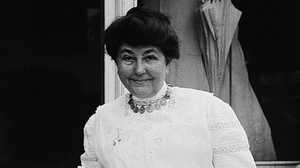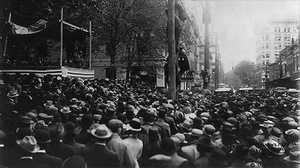Carrie Chapman Catt

A dynamic speaker and tenacious organizer, Carrie Chapman Catt was a powerful force in the women's suffrage movement. Her relentless campaigning won Woodrow Wilson's respect and support, and ultimately led to passage of the Nineteenth Amendment granting women the right to vote.
Born in Wisconsin in 1859, Carrie Lane moved with her family to Iowa at the age of seven. She graduated from Iowa State University as the only woman in her class and soon began work as a teacher, principal, and school superintendent. She married newspaper editor Leo Chapman in 1885, but their marriage was cut short one year later when he died suddenly of typhoid fever. Four years later, she married wealthy engineer George Catt.
Carrie Chapman Catt took her first step as a political activist in 1886 when she joined the Iowa Woman Suffrage Association. She soon served as a delegate to the newly formed National American Woman Suffrage Association (NAWSA). By 1900, Catt succeeded the 80-year-old activist Susan B. Anthony as its president. She took the fight for women's rights to the world stage, organizing the International Woman's Suffrage Association in 1902. She chose to curtail much of her suffrage work in 1904, though, to care for her ailing husband.
In the years following her husband's 1905 death, a grieving Catt resumed her work, concentrating on women's rights in the international arena. Under other leadership, the national organization, NAWSA, became divided, sorely in need of Catt's energy and direction. Catt was not a firebrand suffragist; rather, she worked on many fronts and used compromises to advance her cause strategically. After hearing Catt address a women's suffrage convention in Canton, New York in 1914, a reporter described her speech as factual, conciliatory and delivered so as not to offend. After reassuming leadership of NAWSA in 1915, she clashed with the faction led by the far more combative Alice Paul, who wanted to work for a constitutional amendment only at the federal level. Catt saw that suffrage at the state level could help strengthen the movement for a Constitutional amendment -- and where complete state suffrage could not be enacted, Catt would settle for a partial solution. The schism led Paul's faction to abandon NAWSA and form what would become the National Woman's Party. But it was Catt's leadership - progressive but not radical - that finally led President Wilson to throw his support behind the amendment.
Fifty-one years after Susan B. Anthony and Elizabeth Cady Stanton founded NAWSA, the Nineteenth Amendment gave women the vote in 1920. Following this victory,Catt helped establish the League of Women Voters to give American women guidance in using their new franchise. In her later years, Catt spoke on behalf of working women, worked for pacifism, organized the National Conference on the Cause and Cure of War, and lobbied for Jewish refugee relief efforts. Shortly before her death in New Rochelle, New York in 1947, she would even lend her hand in the founding of the United Nations.







